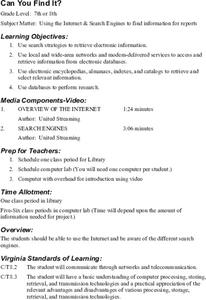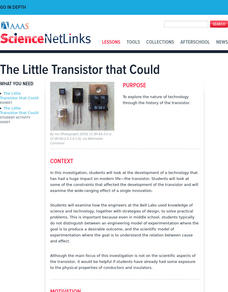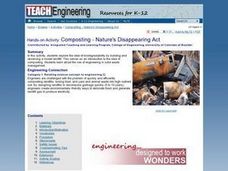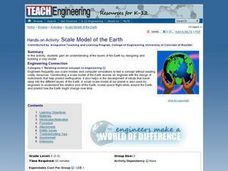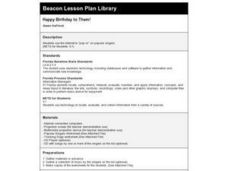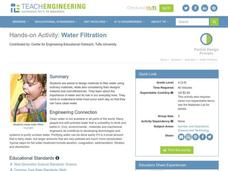Curated OER
Investigating the Technological Impacts on N.C.
Fourth graders search the internet to identify ways in which technology has influenced the lives of North Carolinians.
Curated OER
Exploring the Internet Properly
Students explore subscription databases, directories, and search engines to find information about a native Michigan animal. They research using the Internet and develop an understanding and appreciation for the resources available.
Curated OER
Can You Find It?
Students use the Internet and search engines to research a foreign country. They use the Internet and library to further their understanding on how to use those resources.
Curated OER
Rocket Me into Space
Fourth graders study the concept of thrust and how it propels rockets into space. They discover why airplanes cannot travel into space while considering the engineering techniques use in designing rockets. They look at how space...
Curated OER
FRAM: The Most Famous Ship in the World
Seventh graders role play the roles of naval engineer apprentices. In groups, they work together to design a ship which cannot be damaged by freezing ice. They use the internet to research the weather and ocean conditions of the water...
Curated OER
Flow Rates of Faucets and Rivers
Students work together to discover the flow rates of faucets and rivers. They relate their results to engineering and applied science concepts. They make predictions on the flow rate of a nearby river in their local community.
Curated OER
Issues Awareness
Students work together to create a survery about environmental issues in their community. They calculate and graph the results. They discuss the importance of surveys to engineers.
Curated OER
TE Activity: Write On!
Learners write a book, newspaper, or other chose published writing that explains the connection between engineering and the environment. They determine why engineers need to be good communicators.
Curated OER
Solar System
Students create and present PowerPoint presentations on certain aspects of our Solar System. The Nettrekker search engine is used for researching the information. Students can then add music and graphics to enhance their presentations.
Curated OER
The Little Transistor That Could
Students research the history of the transistor to explore the nature of technology. They complete a worksheet that coincides with given websites. Then they write a one-page essay about their findings.
Curated OER
Composting -- Nature's Disappearing Act
Studenst work together to discover the concept of biodegradability. They build a model of a landfill and how different items decompose. They examine how engineers use this information for better waste management.
Curated OER
Ready to Erupt!
Students observe a visual representation of a volcano erupting. They measure and sketch the volcano and discuss how engineers use this information. They discover the type of equipment used to indicate an eruption.
Curated OER
Scale Model of the Earth
Pupils work together to create a model of the Earth. They label and identify each layer and describing its properties. They discover how engineers use models to test different concepts.
Curated OER
Native American Unit: Introduction to Internet Searching Strategies
Students observe a model classroom of students using the internet. Prospective teachers explore the advantages to taking kids to search engines while in a computer lab. They discuss strategies that are appropriate to teach students and...
Curated OER
Density
Students, in groups, design a procedure to calculate the mass of gas molecules in the classroom by measuring the volume of the classroom and researching the density of air. They apply changes in air density with altitude and effects on a...
Curated OER
TE Activity: Build Your Own Mobile
Young scholars inquire into how the center of mass is the key factor in designing cars. They construct an oddly shaped object and determine its center of mass. They find that engineers are able to predict how objects will behave while...
Curated OER
Science: Designer genes
Students engineer new organisms using biotechnology. In small groups, they write procedures, list benefits and drawbacks, and explain how their new organism might affect the environment. After creating their new organisms, they present...
Curated OER
TECH:Robotic Hazardous Materials Squad
Students use a remote controlled robot to simulate a hazardous materials removal exercise. They are introduced to the following career: Robotics, Hazardous Materials Specialist, Robotic Technician, Environmental Scientist, Manufacturing...
Curated OER
Glow With the Flow
Students investigate the force of drag and how NASA engineers use models and glowing paints to examine how air flows over vehicles in a wind tunnel. They discover how the blended wing body will affect air travelers of the future.
Curated OER
Happy Birthday to Them!
Third graders use a search engine to search the Internet and find the birthdates of the singers listed on the Popular Singers Worksheet. They provide the URL address from which they obtain their information for each singer.
Curated OER
Does Contact Area Matter?
Learners work together to design and implement an experiment on friction. They test to see if contact area affects the amount of friction. They discover how engineers use friction to make certain products better.
Curated OER
How Do Things Fall?
Students observe falling objects. They discover the rate of falling is based on air resistance and not the weight of the objects. They discuss how engineers use this type of information to design aerodynamic shapes.
Curated OER
Water Filtration
Students work together to examine the role of water in their lives. They discover the process to clean water so it is clean for one to drink. They explore the role of environmental engineers and their problem of getting clean water to...
Curated OER
TE Activity: The Boxes Go Mobile
Students create a mobile of boxes and cubes that they made in a previous lesson that can be accessed from this page. They design the mobile using method that an engineer would use to balance the items based on surface areas and volumes.




